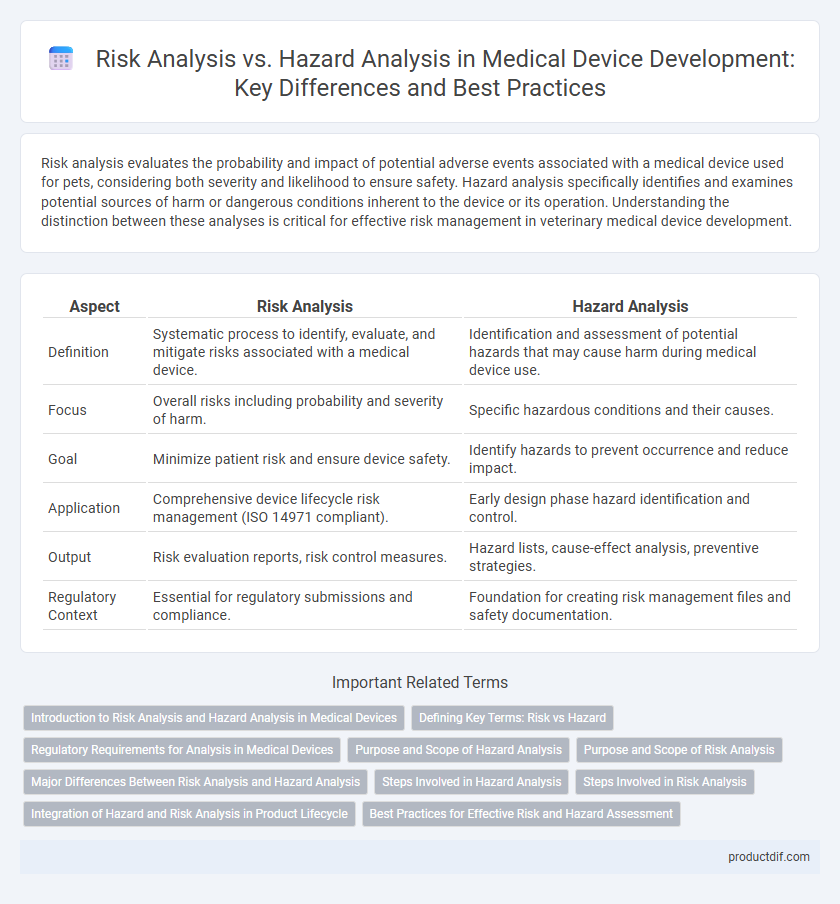Risk analysis evaluates the probability and impact of potential adverse events associated with a medical device used for pets, considering both severity and likelihood to ensure safety. Hazard analysis specifically identifies and examines potential sources of harm or dangerous conditions inherent to the device or its operation. Understanding the distinction between these analyses is critical for effective risk management in veterinary medical device development.
Table of Comparison
| Aspect | Risk Analysis | Hazard Analysis |
|---|---|---|
| Definition | Systematic process to identify, evaluate, and mitigate risks associated with a medical device. | Identification and assessment of potential hazards that may cause harm during medical device use. |
| Focus | Overall risks including probability and severity of harm. | Specific hazardous conditions and their causes. |
| Goal | Minimize patient risk and ensure device safety. | Identify hazards to prevent occurrence and reduce impact. |
| Application | Comprehensive device lifecycle risk management (ISO 14971 compliant). | Early design phase hazard identification and control. |
| Output | Risk evaluation reports, risk control measures. | Hazard lists, cause-effect analysis, preventive strategies. |
| Regulatory Context | Essential for regulatory submissions and compliance. | Foundation for creating risk management files and safety documentation. |
Introduction to Risk Analysis and Hazard Analysis in Medical Devices
Risk analysis in medical devices involves identifying, evaluating, and mitigating potential risks associated with the device throughout its lifecycle to ensure patient safety and regulatory compliance. Hazard analysis focuses specifically on recognizing and assessing hazardous situations or failure modes that could cause harm during device use or malfunction. Both processes are critical components of the risk management framework defined by ISO 14971, guiding manufacturers to systematically control device-related risks and improve overall safety.
Defining Key Terms: Risk vs Hazard
Risk in medical devices refers to the combination of the probability of occurrence of harm and the severity of that harm, influencing patient safety and device performance. Hazard is any potential source of harm or adverse health effect associated with the device, including mechanical, electrical, or biological factors. Understanding the distinction between risk and hazard is critical for effective risk management and compliance with regulatory standards such as ISO 14971.
Regulatory Requirements for Analysis in Medical Devices
Risk analysis in medical devices involves evaluating potential risks associated with device use, focusing on probability and severity of harm, while hazard analysis identifies specific hazards that could cause adverse effects. Regulatory requirements, such as FDA 21 CFR 820 and ISO 14971, mandate thorough risk management processes encompassing both analyses to ensure device safety and compliance. Effective risk and hazard analyses support proactive identification, control, and mitigation of risks throughout the medical device lifecycle.
Purpose and Scope of Hazard Analysis
Hazard analysis in medical device development focuses on identifying potential hazards that could cause harm during the device's entire lifecycle, emphasizing safety and compliance with regulatory standards like ISO 14971. The purpose of hazard analysis is to systematically evaluate risks to patient and user safety, establishing risk control measures to mitigate or eliminate identified hazards. Its scope includes all stages from design and manufacturing to disposal, ensuring comprehensive risk management throughout product development and use.
Purpose and Scope of Risk Analysis
Risk analysis in medical devices systematically identifies, evaluates, and mitigates potential risks to ensure patient safety and regulatory compliance. It encompasses the entire lifecycle of the device, addressing potential harm from device failure, human error, and environmental factors. The purpose of risk analysis is to minimize adverse effects through proactive measures, whereas hazard analysis primarily focuses on identifying specific hazards without comprehensive evaluation or control strategies.
Major Differences Between Risk Analysis and Hazard Analysis
Risk analysis in medical devices evaluates the likelihood and severity of harm occurring during device use, focusing on estimating risks to patient safety. Hazard analysis identifies potential sources of harm, concentrating on detecting and defining hazards before they materialize into risks. The major difference lies in risk analysis quantifying risk levels for decision-making, whereas hazard analysis functions as an early step to systematically recognize and characterize hazards.
Steps Involved in Hazard Analysis
Hazard analysis in medical device development involves identifying potential sources of harm, assessing the severity and likelihood of each hazard, and implementing control measures to mitigate risks. Key steps include hazard identification, hazard characterization, exposure assessment, and risk estimation, ensuring a comprehensive evaluation of possible device-related hazards. This systematic approach prioritizes patient safety by addressing hazards before risk analysis integrates broader risk management processes.
Steps Involved in Risk Analysis
Risk analysis in medical device development involves identifying potential risks, estimating their severity and probability, and evaluating risk control measures to ensure patient safety. Key steps include hazard identification, risk estimation, risk evaluation, risk control implementation, and residual risk assessment to comply with ISO 14971 standards. Hazard analysis focuses on pinpointing possible hazards, while risk analysis extends to quantifying and managing those risks throughout the device lifecycle.
Integration of Hazard and Risk Analysis in Product Lifecycle
Integration of Hazard and Risk Analysis in the medical device product lifecycle ensures comprehensive identification, evaluation, and mitigation of potential safety issues. By combining hazard identification with risk estimation and control measures, manufacturers can enhance regulatory compliance and improve patient safety throughout design, development, and post-market phases. This unified approach streamlines documentation and supports continuous monitoring and updating of risk management files in accordance with ISO 14971 standards.
Best Practices for Effective Risk and Hazard Assessment
Effective risk and hazard assessment in medical device development requires a clear distinction between Risk Analysis, which evaluates potential adverse events and their likelihood, and Hazard Analysis, which focuses on identifying possible sources of harm. Best practices include applying ISO 14971 standards for systematic risk management and utilizing Failure Modes and Effects Analysis (FMEA) to prioritize hazards based on severity and occurrence. Integrating multidisciplinary teams ensures comprehensive identification and mitigation of risks and hazards throughout the device lifecycle.
Risk Analysis vs Hazard Analysis Infographic

 productdif.com
productdif.com